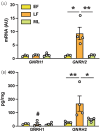Pituitary gonadotropin-releasing hormone II as a possible mediator of positive estrogen feedback
- PMID: 39924866
- PMCID: PMC11975487
- DOI: 10.1111/jne.13498
Pituitary gonadotropin-releasing hormone II as a possible mediator of positive estrogen feedback
Abstract
It has previously been shown that rhesus macaques express two forms of gonadotropin-releasing hormone (GNRH1 and GNRH2) in the hypothalamus and that both forms can stimulate the release of luteinizing hormone (LH) in vivo. However, while much has been published about the role of GNRH1 in reproduction, very little is known about the hypophysiotropic function of GNRH2. To shed light on this issue, we studied the expression pattern of these two genes in different parts of the monkey hypothalamus and pituitary gland under controlled conditions of circulating estrogen levels, using qPCR, liquid chromatography with tandem mass spectrometry and RNAscope. GNRH1/GNRH1 expression was found throughout the hypothalamus and was largely unaffected by circulating estradiol levels. In contrast, GNRH2/GNRH2 expression was found to be enhanced by long-term treatment with estradiol and during the late follicular phase of the menstrual cycle, especially in the arcuate nucleus and pituitary gland. Together these findings suggest that pituitary GNRH2/GNRH2 (but not GNRH1/GNRH1) is induced by positive feedback-like levels of estradiol. This novel finding raises the possibility that GNRH2 plays a major role in triggering the preovulatory LH surge in primates, not only at the level of the hypothalamus but also the pituitary gland.
Keywords: GNRH2; LC‐MS/MS; estradiol; gonadotropin‐releasing hormone type II.
© 2025 The Author(s). Journal of Neuroendocrinology published by John Wiley & Sons Ltd on behalf of British Society for Neuroendocrinology.
Conflict of interest statement
The authors declare that there is no conflict of interest that could be perceived as prejudicing the impartiality of the research reported.
Figures





References
-
- Knobil E, Neill JD. The Physiology of Reproduction. 2nd ed. Raven Press; 1994.
MeSH terms
Substances
Grants and funding
LinkOut - more resources
Full Text Sources

